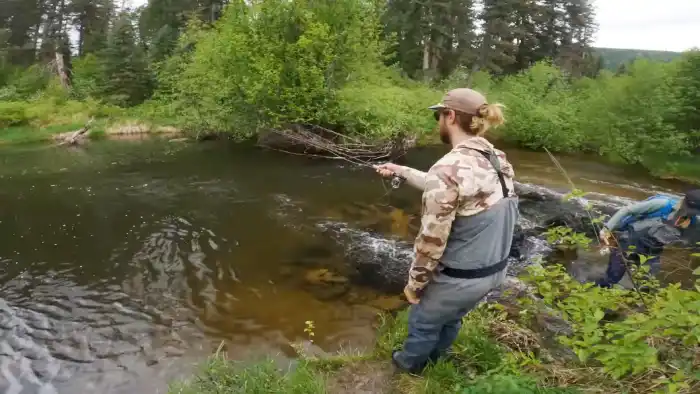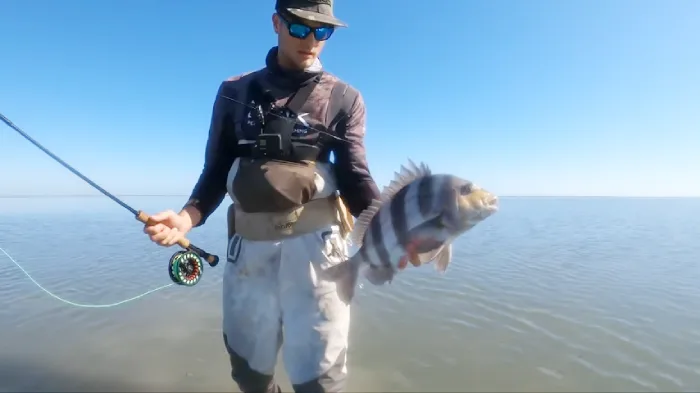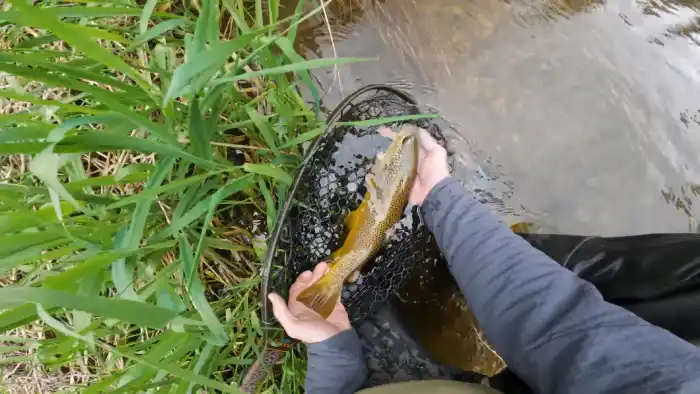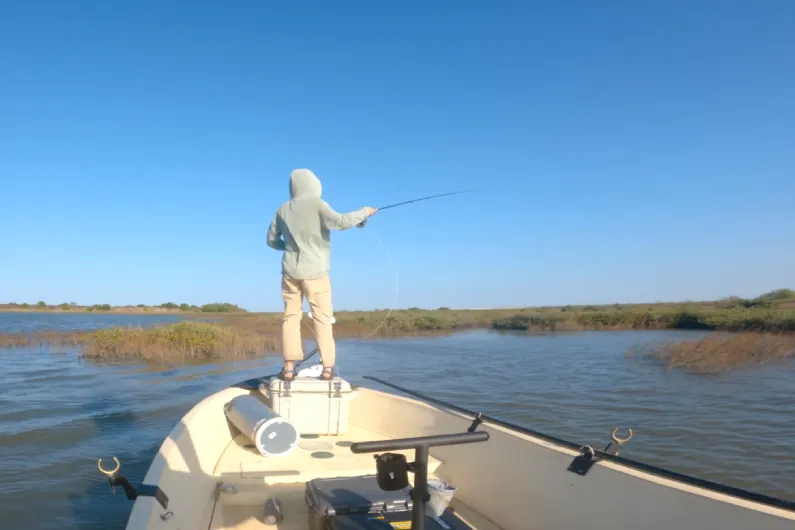Key Takeaways:
- Texas offers diverse fly fishing locations, including Devils River, Blanco River, Guadalupe River, Llano River, and more.
- Target species in these rivers vary, but anglers can expect opportunities to catch bass (largemouth, smallmouth, and Guadalupe), trout, sunfish, catfish, striped bass, and more.
- Fly fishing is suitable year-round in many Texas rivers, but the best times may vary depending on weather and water conditions.
- Obtain the appropriate fishing licenses, freshwater or saltwater endorsements, and adhere to regulations set by the Texas Parks & Wildlife Department to fish legally and responsibly in Texas waters.
- Texas coastal areas like Laguna Madre and Lake Texoma also provide excellent fly fishing opportunities for species like redfish, speckled trout, sheepshead, and flounder.
Top 16 Fly Fishing Spots in Texas You Need to Fish

Fly fishing is one of the best things to do in Texas. Here are the top 16 places to try it.
- Devils River
- Blanco River
- Guadalupe River
- Llano River
- Lampasas River
- Pedernales River
- San Gabriel River
- San Marcos River
- Colorado River
- Red River and Lake Texoma
- Cypress Creek
- Canyon Lake
- Lake Anahuac
- Lake Conroe
- Texas Coast between Rockport and Port O’Conner
- Laguna Madre
Let’s discuss fly fishing in Texas in more detail:
1. Devils River
- Located in Southwest Texas amid harsh desert terrain, making it a hidden gem for fly fishing.
- Crystal clear, spring-fed water provides ample opportunities for fly fishing, particularly for large and catchable bass and challenging carp.
- Anglers can access the river at Dolan Falls, so float the river if you have the time to see everything.
2. Blanco River
- Blanco River is located in Texas, specifically in the Texas Hill Country region, offering 87 miles of water from natural springs for fly fishing.
- Pristine, spring-fed water with easy access for fly fishing enthusiasts, making it suitable for panfish, smallmouth & largemouth bass, and Guadalupe bass.
- The river offers ample opportunities for long casts and light leaders, making it suitable for fly fishing enthusiasts. You can fish without a Texas fishing license from the shore and borrow rods and reels if available.
3. Guadalupe River
- Situated between Kerr County, Texas, to San Antonio Bay on the Gulf of Mexico.
- Holds the only wild-born Texas trout in the state, making it a popular spot for trout fishing. It’s also a diverse fishery, including rainbow and brown trout and trophy bass.
- The river offers low to moderate fishing pressure, making it an excellent angler spot. You can access the river at Guadalupe Park and Camp Huaco Springs.
4. Llano River
- Llano River is located in the Lower Llano near Kingsland, Llano, and Mason, in the Texas Hill Country.
- Best known for its clear waters and excellent sight fishing opportunities for bass and sunfish and can be fished year-round, with winter conditions.
- The river bottom is mostly granite and sand, and various access points are along the river for public fishing.
5. Lampasas River
- Located in northern Texas, flows across Central Texas and empties into an artificial reservoir called Stillhouse Hollow Lake.
- Offers a taste of a mountain stream with narrow, shallow waters and thick vegetation along the banks that provide a suitable habitat for various fish species.
- The best time to fish the Lampasas River is during winter when water temperatures are cooler, fish are more active, and the recommended fishing area is near Stillhouse Hollow Lake.
6. Pedernales River
- A 106-mile-long river flows west to east across the Texas Hill Country, and the best area to fish is within Pedernales Falls State Park.
- Features scenic beauty, with tumbling waterfalls and natural limestone formations, creating pools with decent-sized bass and carp.
- Offers excellent fly fishing conditions year-round, but fishing in the deeper pools of water during summer is recommended.
7. San Gabriel River
- Located near Georgetown, Texas, and flows through central Texas and is broken up into three sections: South, Middle, and North.
- A lush green vegetation surrounds the water, including pecan and cottonwood trees that give shelter from the sun.
- Ideal for both novice and experienced fly anglers with its diverse fish species, including Guadalupe Bass, Largemouth Bass, and Smallmouth Bass.
8. San Marcos River
- Prime fly fishing location in Texas located in San Marcos Springs, Texas, A&M University campus in central Texas.
- The beautiful limestone river bottom creates picturesque pools and offers great sight-fishing opportunities.
- Considered one of the most biologically diverse aquatic ecosystems with various endangered species and offers a unique and vibrant fishing experience.
9. Colorado River
- Runs through Texas and has stretches of river below Austin, Columbus, Bastrop, La Grange, Austin, and Ballinger.
- The long river stretches between put-ins and takeouts reduce fishing competition and are recommended for boat fishing to cover a large, unexplored area.
- Ideal bass fishing spot with diverse fish species, such as largemouth bass, smallmouth bass, Guadalupe bass, and panfish. Suitable for fishing year-round with temperature considerations.
10. Red River and Lake Texoma
- Located along the border between Texas and Oklahoma, with an 88,000-acre water conservation reservoir on the Red River.
- Striped bass fishing with generous catch limits and various other species of bass.
- Fly fishing can be productive throughout the year with different tactics, such as stripping streamers, using topwater poppers, and fishing deep with sinking lines.
11. Cypress Creek
- A spring-fed river that starts at Jacob’s Well and joins the Blanco River in Texas.
- Clear water for excellent visibility and a reliable flow for year-round fishing. Anglers can enjoy fishing from tree-shaded banks, kayaks, or paddle boats.
- Options for both free and private access sections, some of which may require payment for access.
- Fishing opportunities for striped, white, and yellow bass are plentiful.
12. Canyon Lake
- An 8,500-acre reservoir formed by the Guadalupe River in the Texas Hill Country, about an hour away from Houston.
- Known as the “Jewel of the Texas Hill Country” with clear, deep waters and the southernmost trout fly-fishing spot in the state.
- Popular for recreational activities and may encounter competition from other water enthusiasts and offers opportunities to catch various species of bass, striped bass, catfish, carp, and gar.
13. Lake Anahuac
- Located east of downtown Houston, Texas, just an hour’s drive from Houston.
- Offers a unique opportunity for anglers to fish for fresh and saltwater species in a beautiful environment.
- The abundance of fish species, including largemouth bass, white bass, and speckled trout, makes it a popular fly fishing destination.
14. Lake Conroe
- Located approximately an hour’s drive from Houston, Texas, and fed by the San Jacinto River
- This lake offers clear, deep waters and rocky shorelines, providing ample opportunities for fly fishing enthusiasts.
- The population of different fish species, like largemouth bass, smallmouth bass, white bass, and Guadalupe bass, provides anglers with a wide range of options for their fly fishing experience.
15. Texas Coast Between Rockport and Port O’Conner
- The Texas coast is located between Rockport and Port O’Conner.
- One of Texas’s primary locations for sportfishing, this area offers emerald waters and an abundant sport fish population.
- Anglers can enjoy year-round redfish fishing and targeting black drum, sheepshead, sea trout, tarpon, and flounder in different seasons.
16. Laguna Madre
- A shallow lagoon that runs approximately 130 miles off the west coast of Texas, from south of Corpus Christi to the Mexican border.
- Offers a variety of game fish for anglers due to its saltwater flats and crystal-clear waters.
- The shallow waters and saltwater flats make sight fishing an exciting option, with the opportunity to spot prey up to 100 feet away. In warmer months, anglers can target species such as redfish, sheepshead, flounder, black drum, sea trout, tarpon, and jack crevalle.
What is the best time to fly fish in Texas?

Generally, Spring and Fall are the prime seasons for fly fishing in Texas due to the milder weather and better water conditions. Early mornings and evenings are also ideal times for fishing because of the cooler temps and increased fish activity.
However, different rivers and lakes in Texas have different best fishing times. For example, the Devils River is best early in the morning or at sunset because of the climate in the area. The Blanco River is most productive in the spring and fall, but summer fishing depends on the water level.
The Guadalupe River is great for fishing during the cooler months from late fall to early spring when the trout are feeding actively. Also, the Lampasas River is best in winter when temperatures are cooler, and fish are more active.
Fly fishing in the Pedernales River is excellent year-round, but focus on deeper pools during summer for better results. The San Gabriel River is ideal for fishing early in the morning, just after midday, and early in the evening.
As for the San Marcos River, the best fishing times vary depending on the season and weather conditions. However, you may have better luck fishing during cooler months or early mornings and evenings.
If you want to fly fish for striped bass, try the Lake Texoma and the Red River. Cypress Creek is best for winter fishing, while Canyon Lake and the Texas coast between Port O’Conner and Rockport offer fly fishing opportunities year-round.
Which fish species can be caught in Texas using fly fishing?
The elusive Permit is known to have picky feeding habits and can be quite wary, making it challenging to catch. Bass, including the Largemouth and Smallmouth varieties, are active feeders during spring and fall in Texas rivers, lakes, and reservoirs.
The Guadalupe Bass is native to rivers and streams in the Texas Hill Country and is known for its aggressive nature and willingness to take flies. Trout, such as the Rainbow and Brown varieties, can be found in specific Texas rivers like the Guadalupe, where they were born wild.
Striped Bass is best caught in certain areas like Lake Texoma during the colder months, while White Bass is found in various Texas lakes and reservoirs, known for their strong spawning migrations in spring and fall.
Panfish like Bluegill and Sunfish are active and easily caught in Texas lakes, ponds, and rivers during spring and fall. Black Drum can be found along the coast in areas like the Laguna Madre during spring and fall, while Red Drum (also known as Redfish) is widespread along the Texas Coast year-round.
Sheepshead can often be found in coastal waters around structures like jetties and piers when they are active during spring and fall. Finally, Flounder is best fished in coastal areas and estuaries during spring and fall.
What are the fly fishing regulations in Texas?

In Texas, fly fishing regulations are regulated by the Texas Parks and Wildlife Department (TPWD). The following are some regulations:
- Fishing License Requirements: A valid Texas fishing license with the appropriate endorsement is required for fly fishing in public waters in Texas. Saltwater and freshwater endorsements are necessary for coastal and inland waters, respectively. Separate licenses may be required for specific areas (e.g., Lake Texoma).
- Unlawful Activities: Prohibited activities include taking endangered species, using game fish as bait, transporting live non-game fish from specific waters without a permit, and placing tracking devices on fish.
- Tagging Fish: While it is legal to place an identification tag on the exterior of a fish, it is unlawful to release a fish with an implanted tracking device.
- Waste of Fish: It is illegal to leave edible fish or bait fish taken from public waters to die without the intention of retaining them for consumption or bait.
- Bait Regulations: Regulations cover the use of live bait, including shrimp native to the Gulf of Mexico, and restrictions on transporting live fish between water bodies.
- Possession of Fish Taken from Public Water: Rules apply to retaining fish and verifying length and species before removing the head or tail.
- Transfer and Importation of Wildlife and Aquatic Resources: Regulations cover the transfer and importation of legally taken wildlife or aquatic resources, including the need for a Wildlife Resource Document (WRD) and valid licenses from other states or countries.
- Fly Fishing in Special Areas and Restrictions: Some areas have specific regulations that anglers should know before fishing. In an area 1,000 feet below Livingston Dam to a point 1,500 feet downstream from the dam, it’s illegal to leave a barge, boat, or fishing platform unattended for any period of time.
#Note: These regulations may change over time, and staying updated with the Texas Parks & Wildlife Department for the latest information is essential.

